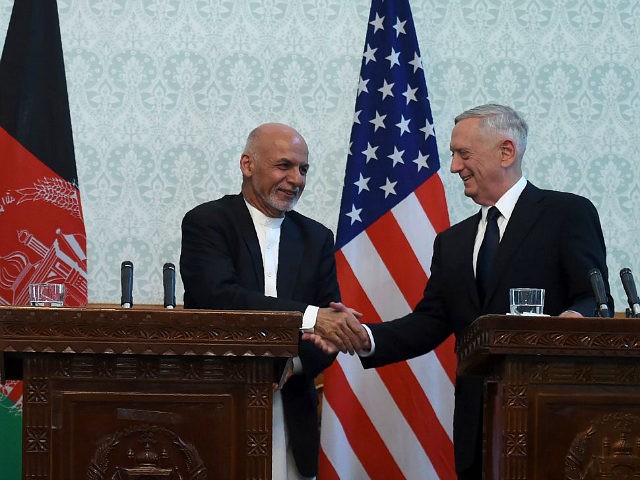U.S. troops and their NATO allies will be able to leave Afghanistan “within four years,” at which time the struggling Afghan National Defense and Security Forces (ANDSF) will be able to protect their country on their own, Afghan President Ashraf Ghani tells BBC.
Ghani also praised U.S. President Donald Trump’s decision to base American troop levels in Afghanistan on “conditions on the ground and not arbitrary timetables.”
The Afghan leader’s remarks may rile up U.S. military officials who have refused to provide anything that resembles a withdrawal date since President Trump unveiled his war strategy in August, emphasizing that ground conditions will dictate America’s presence in the country, not timetables.
On Tuesday, Marine Gen. Joseph Dunford, the chairman of the Joint Chiefs of Staff, told a congressional panel that “there is no time horizon” for the foreign presence in Afghanistan.
Nevertheless, when asked by BBC when he thinks the U.S.-NATO coalition can withdraw from Afghanistan, President Ghani responded, “Within four years, we think our security forces would be able to do the constitutional thing, which is the claim of legitimate monopoly of power.”
“Many military analysts will consider that optimistic given that it is only three years since the NATO combat mission ended and the Afghan military took responsibility for the battle against the Taliban and other insurgent groups,” acknowledges BBC.
Ghani’s comments came as the new American ambassador to NATO revealed that the United States is planning to ask the alliance to contribute an estimated 1,000 additional troops to fight against the resurgent Taliban and other jihadists in Afghanistan alongside American forces.
According to Amb. Kay Bailey Hutchinson, the Trump administration expects to see “1,000 or so allied troops” join the additional 3,000 American forces who are already on their way to Afghanistan to train and advise the ANDSF under the new U.S. strategy, reports the Agence France-Press (AFP) news agency.
Despite the billions of dollars the United States has spent to develop and train the Afghan security forces, they continue to suffer from capability gaps.
However, the ANDSF is willing to fight terrorism, bearing the brunt of the jihadi attacks across the country.
The ANDSF, which includes police and army units, and Afghan civilians have suffered a historic number of casualties in recent years.
“Afghan losses have been the greatest of all: more than twice as many ANDSF members were killed in the single year of 2016 than U.S. forces in Afghanistan have lost [2,258 now] since 2001,” reported the Special Inspector General for Afghanistan Reconstruction (SIGAR).
This week, U.S. military leaders suggested that Afghan forces are currently unable to win without the support of American military advisers, adding that the United States would remain in Afghanistan for a long time.
“We may have advisers there ten years from now,” U.S. Defense Secretary James Mattis told lawmakers as he testified alongside Gen. Dunford.
“We’re not winning, and it’s at a stalemate,” declared Dunford. “That’s my assessment of where we are right now. We’re not at a point where we can bring a successful political conclusion to the war.”
The U.S. military has described the state of the war in Afghanistan as a “stalemate” for months now.
On Tuesday, Mattis and Dunford testified during two congressional hearings focused on Trump’s South Asia strategy, which primarily covers the war in Afghanistan.
Gen. Dunford told U.S. lawmakers that the Taliban no longer has the timetable for America leaving that motivated them to fight under the previous administration.
“We want them to have no hope of ever winning,” added Mattis.
President Trump inherited a deteriorating security situation in Afghanistan, primarily fueled by the Taliban and its allies.
The Taliban is now in control of more territory now than during any other time since it was deposed from power in Afghanistan in late 2001.
Secretary Mattis explained to lawmakers that an intensified offensive against the Taliban would pressure the jihadists into reconciliation with the Kabul government that will end the war.
When announcing his South Asia strategy this year, President Trump vowed to ask NATO for additional help in Afghanistan.
“We will ask our NATO allies and global partners to support our new strategy with additional troop and funding increases in line with our own,” proclaimed the American commander-in-chief. “We are confident they will.”
“Since taking office, I have made clear that our allies and partners must contribute much more money to our collective defense, and they have done so,” he added. “In this struggle, the heaviest burden will continue to be borne by the good people of Afghanistan and their courageous armed forces.”
The new foreign troop deployments are expected to bring the total number of U.S. fighters to nearly 14,000 and NATO forces to about 6,000, for an estimated total of 20,000.
Recent data shows that there are also at least 1,600 coalition troops from non-NATO allies in Afghanistan.

COMMENTS
Please let us know if you're having issues with commenting.